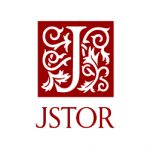Back issues of many IA numbers are available from the Society for Industrial Archeology; follow this link for ordering information. For access to out-of-print numbers via JSTOR.org, follow the link to the right.
Current Issues
Volume 40, Number 1 and 2, 2014
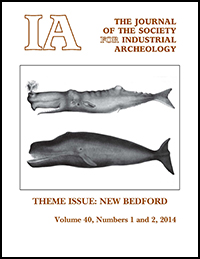 |
THEME ISSUE: NEW BEDFORD
Articles Foreword: Kingston Wm. Heath and Randall May Heath “From Whalers to Weavers: New Bedford’s Urban Transformation and Contested Identities,” Kingston Wm. Heath “A Peculiarly Valuable Oil: Energy and the Ecology of Production on an Early American Whale Ship, Bob Johnson “New Bedford: Whale Oil Refining Capital,” Mark Foster “The River and the Rail: The Industrial Evolution of the Port of New Bedford,” Michael Dyer “Water Wealth: The Quest for Economic Revival and a Public Water Supply in Nineteenth-Century New Bedford, Massachusetts,” Arthur P. Motta, Jr. “Steam Mills in a Seaport: Power for the New Bedford Textile Industry,” Patrick M. Malone “The Weave Sheds of New Bedford and their Place in American Industrial Architecture,” Charles Parrott Published in 2017, back issues available. |
Volume 39, Number 1 and 2, 2013
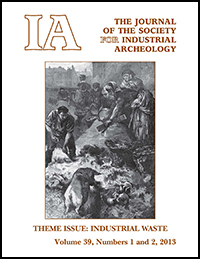 |
THEME ISSUE: INDUSTRIAL ARCHEOLOGY OF INDUSTRIAL WASTE
Articles Foreword: Carl A. Zimring, Pratt Institute “It’s Not Time to Be Wasted: Identifying, Evaluating, and Appreciating Mine Wastes in Michigan’s Copper Country,” Sean M. Gohman “The Archeology of Coal Ash: An Industrial-Urban Solid Waste at the Dawn of the Hydrocarbon Economy,” Samantha MacBride “Nuisance, Source of Wealth, or Potentially Practical Material: Visions of Tailings in Idaho’s Coeur d’Alene Mining District, 1888–2001,” Fredric L. Quivik “The Rise and Fall of the Tacoma Arsenic Industry,” Lloyd B. Tepper and Jeffrey H. Tepper “Infamous Past, Invisible Present: Searching for Bubbly Creek in the Twenty-First Century,” Carl A. Zimring and Michael A. Bryson “’Junkyard Jamboree’: Hunting for Automotive Treasure in the Twentieth Century,” David N. Lucsko Published in 2016, back issues available.
|
Volume 38, Number 2, 2012
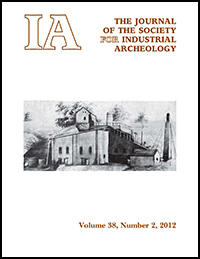 |
Articles “From the Archive to Web 2.0: The Use of GIS and WebGIS Applications in Industrial Archeology,” Massimiliano Grava “The Iron Mountain Mine: Tracing a Montana Silver-Lead Mine from Success to Bust Through Engineering and Management Decisions,” Marty Johnston “From Mary Furnace to Sharon Steel: Evolution and Integration of the United States’ Last Manually Filled Blast Furnace, 1845–1963,” Clayton J. Ruminski “Verne’s Jewels: Childhood Memories of Industrialization Encroaching on Farm Life in Minnesota,” Verne Lace Review Essay: “Forging a Multi-faceted Discipline: A Review Essay of Industrial Heritage Re-tooled: The TICCIH Guide to Industrial Heritage Conservation,” edited by James Douet, reviewed by Robert W. Passfield Published in 2015, back issues available. |
Volume 38, Number 1, 2012
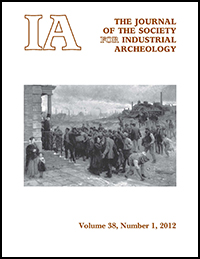 |
Articles “‘I trust there will be no failure . . .’: The Importance of Bricks and Brickmaking at the Adirondack Iron and Steel Company’s Upper Works,” David P. Staley, Peter R. Mills, and Steven P. Lundblad “Conspicuous Iron and the Cochituate Aqueduct Gatehouses: The Earliest Extant American Wrought-Iron Roof and Roof Trusses, and the Earliest Extant Cast-Iron Staircases for Public Use,” Dennis J. De Witt “The Cruttenden Carriage Works: The Development and Decline of Carriage Production in New Haven,” Connecticut, Ben Ford “The Material Significance of Carriage Drives to the Design of Central Park,” Kevin Coffee Published in December 2014, back issues available. |
Volume 37, Number 1 and 2, 2011
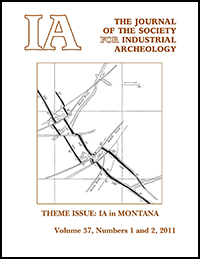 |
THEME ISSUE: IA IN MONTANA
Articles Foreward: Brian Shovers, Montana Historical Society “The Soviet Problem with Two ‘Unknowns’: How an American Architect and a Soviet Negotiator Jump-Started the Industrialization of Russia, Part II,” Saul G. Bron and Sonia Melnikova-Raich “‘A Wonderful Piece of Engineering’: The Point of Rocks Segment of the Mullan Road and the Milwaukee Road Railroad in Mineral County, Montana,” Jon Axline “The Short Life of the Montana Smelter, a Custom Silver-Lead Smelter in Great Falls, 1889–1901,” Mitzi Rossillon “Coloma Mining District: Gold Mining and Community in Western Montana’s Garnet Range,” Marta Amelia Timmons and Kelly J. Dixon “From the Big Hole to Butte: The Origins and Evolution of a Rocky Mountain Municipal Water System,” Brian Shovers “Underground Mine Maps & the Development of the Butte System at the Turn of the Twentieth Century,” Eric Nystrom “Architects as Designers of Pre-World War II, Large-Scale Technological Systems: Edward W. Tanner and the Design of the Fort Peck Townsite” Fredric L. Quivik “From State-of-the-Art to Estate for the Arts: The Evolving Cultural Landscapes of the Western Clay Manufacturing Company & the Archie Bray Foundation for the Ceramic Arts,” Patty Dean and Sharon Reid “Boom, Bust, and the Berkeley Pit: How Insiders and Outsiders Viewed the Mining Landscape of Butte, Montana,” Brian Leech Published in July 2014, 188pp, back issues available. |
Volume 36, Number 2, 2010
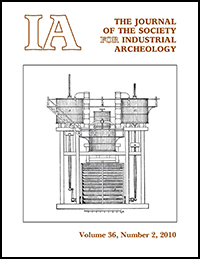 |
Articles “Meeting the Challenge of a Renewable Energy Resource: Small-Scale Milling and Manufacturing in Southern New England,” Robert B. Gordon and Michael S. Raber “Reinventing the Waterwheel: Rediscovering the Knowledge of a Mid-Nineteenth Century Millwright in New England,” John P. Johnson “Electrifying Independence Valley: Mining and Hydroelectricity in Nevada’s Northeastern Frontier (1896–1920),” Christopher W. Merritt and Jacob N. Pollock “The Soviet Problem with Two “Unknowns”: How an American Architect and a Soviet Negotiator Published in April 2013, 96 pages, back issues available. |
Volume 36, Number 1, 2010
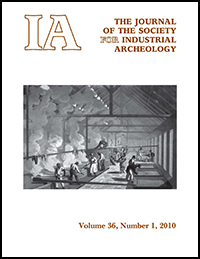 |
Articles “Data-Recovery Excavations at the Plaisance Plantation Sugarhouse, Louisiana” Joanne Ryan, Thurston H. G. Hahn, III, and Donald G. Hunter. “The Production and Negotiation of Working-Class Space and Place at Central Aguirre, Puerto Rico” Sam R. Sweitz “Industrial Mercurialism: Agricola to the Danbury Shakes” Lloyd B. Tepper “The Rise and Fall of the California Stamp: Historical and Archaeological Perspectives on the Aging of a Technology” Paul J. White Published in November 2012, 104pp, back issues available. |
Volume 35, Numbers1 and 2, 2009
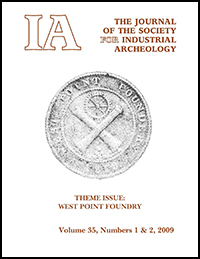 |
THEME ISSUE: WEST POINT FOUNDRY
Articles “Industrial Archaeology and the West Point Foundry,” Patrick Martin “The West Point Foundry in Larger Perspective” Steven A. Walton “The Diary of the Setting-Out of the West Point Foundry” Gouverneur Kemble “Founding A Foundry: The Diary of the Setting-Out of the West Point Foundry, 1817” Steven A. Walton “Using Maps to Aid Our Understanding of a Site’s History” Alicia B. Valentino “From Forest and Mine to Foundry and Cannons: An Archaeological Study of the Blast Furnace at the West Point Foundry” T. Arron Kotlensky “The Gun Foundry Recast” Dan Trepal “Housing A Foundry Community with a ‘Liberal And Philanthropic Spirit'” Elizabeth N. Hartnell “Two Seasons of Excavation at the 1865 Office Building at Scenic Hudson’s West Point Foundry Preserve” Timothy James Scarlett, Michael Deegan, and Renée Blackburn Published in August 2012, 140 pages, back issues available. |
Volume 34, Number 1 and 2, 2008
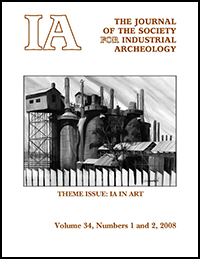 |
THEME ISSUE: IA IN ART
Articles “Industrial Archeology and Art: Negotiating the Past and Present,” Betsy Fahlman “‘Under a Spreading Chestnut-Tree’: The Blacksmith and His Forge in Nineteenth-Century American Art,” James C. Boyles “Cropsey’s Paintings of the “Fog Company” and the Industrial Riverside of Hastings-on-Hudson,” Kenneth W. Maddox “John White Alexander’s Industrial Lunettes for the Pennsylvania State Capitol: The Unfinished Story,” Mary Anne Goley “From Mayville to Milwaukee: The Visual Culture of the Iron and Steel Industry in Southeastern Wisconsin,” John H. Kopmeier, Jr. “Maria Martinez, Industrial Designer,” Cody Hartley “The Town That Photography Built: Images from the Consolidation Coal Company Photograph Collection, 1911–1946,” Rosalind Shipley “From Monuments to Memory Sites: Representing Pennsylvania’s Anthracite Industry in Public Sculpture, 1855–2010,” Jadviga M. da Costa Nunes “Connecticut’s Tobacco Industry: Harold Barbour, Jack Delano, and the WPA,” Cynthia Roznoy “Midwestern Images of Labor: Wisconsin Artists and Their Portrayal of Industry,” James R. Kieselburg, II “Erich Mercker and “Technical Subjects”: Industrial Painting in the Eras of Weimar and Nazi Germany,” Patrick J. Jung Published in 2011, 188 pages, back issues available. |
Volume 33, Number 2, 2007
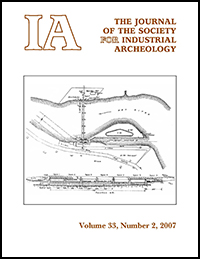 |
Articles “St. Andrew’s Caméré Curtain Bridge Dam, Lockport, Manitoba,” Robert W. Passfield
“The Historical Significance of Tailings and Slag: Industrial Waste as Cultural Resource,” Fredric L. Quivik “Industrial Plumbism: Antiquity to Modern Times,” Lloyd B. Tepper Published in 2011, 84 pages, back issues available. |
Volume 33, Number 1, 2007
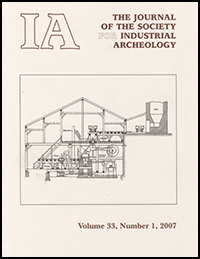 |
Articles “An Archaeological Survey of the Whiteport Cement Works,” Dennis E. Howe
“The Turnkey Factory: Technology Transfer from America to Spain in the Portland Cement Industry,” James Douet Published 2007, 56 pages, back issues available. |
Volume 32, Number 2, 2006
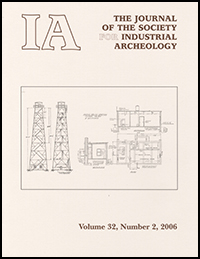 |
Articles “Towers for Telegrams: The Western Union Telegraph Company and the Emergence of Microwave Telecommunications Infrastructure,” David S. Rotenstein
“The Evolution of the Warren, or Triangular Truss,” David Guise “Current Research on the Art of Industry-Artists at Work: Imaging Place, Work, and Process,” Betsy Fahlman Published in 2008, 80 pages, back issues available. |
Volume 32, Number 1, 2006
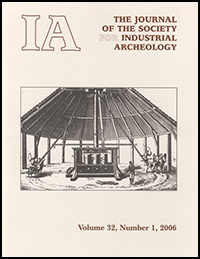 |
Articles “Troubled Waters: Timbisha Shoshone, Miners, and Dispossession at Warm Spring,” Paul J.White
“Industrial Archeology and Environmental Assessments,” Michael Bernstein “Sugar Mills, Technology, and Environmental Change: A Case Study of Colonial Agro-Industrial Development in the Caribbean,” Marco Menketti Published in 2008, 100 pages, back issues available. |
Volume 31, Number 2, 2005
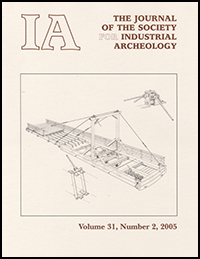 |
Articles Evaluating Authenticity: Reconstructed Timber Swing Bridges by Robert W. Passfield
The F. & H. Benning Company Grinding Mill: A Case Study by Justine christianson Trace Element Constraints on the Source of Silica Sand Used by the Boston and Sandwich Glass Co. (c. 1826-1 888), Massachusetts by J. Victor Owen, Katherine Irwin, Charles L. Flint, and John D. Greenough Published in 2007, 76 pages, back issues available. |
Volume 31, Number 1, 2005
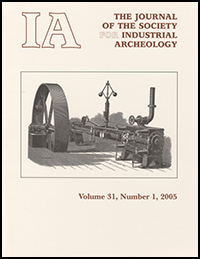 |
Articles Extant Approach Spans of the Dunleith and Dubuque Bridge by Robert W. Jackson
Surplus Water, Hybrid Power Systems, and Industrial Expansion in Lowell by Patrick M. Malone GPR and Archaeological Excavations at the West Point Foundry, New York by Charles T. Young and Kimberly Finch Published in 2006, 64 pages, back issues available. |


